Introduction:
In the world of economics, efficiency plays a crucial role in ensuring optimal resource allocation and maximizing societal welfare. Efficiency can be broadly classified into three main types: productive efficiency, allocative efficiency, and dynamic efficiency. In this blog post, we will delve into the definitions, conditions, and implications of these efficiencies, shedding light on their significance in economic decision-making and policy formulation.
Productive Efficiency:
Productive efficiency refers to a situation where output is maximized given the available inputs and technology. In simpler terms, it implies producing goods and services at the lowest possible cost. Achieving productive efficiency requires minimizing waste, utilizing resources effectively, and optimizing production processes.

Conditions for Productive Efficiency:
To attain productive efficiency, several conditions must be met:
- a) Technical Efficiency: The production process should utilize resources in such a way that it maximizes output for a given set of inputs. Any inefficiencies in production techniques can lead to waste and increased costs.
- b) Cost Minimization: The cost of producing a unit of output should be minimized. This involves selecting the optimal combination of inputs and minimizing any unnecessary expenditures.
Allocative Efficiency:
Allocative efficiency focuses on the distribution of resources in a manner that maximizes societal welfare. It occurs when resources are allocated to produce the combination of goods and services that aligns with consumers’ preferences and societal needs.
Conditions for Allocative Efficiency:

Attaining allocative efficiency requires the following conditions:
- a) Marginal Benefit equals Marginal Cost: Resources should be allocated in such a way that the marginal benefit derived from the last unit produced is equal to its marginal cost. This ensures that resources are allocated to their highest-valued uses, maximizing overall welfare.
- b) No Waste: Allocative efficiency requires the absence of any wasteful or unnecessary production. Resources should be directed towards producing goods and services that are in demand and have value to consumers.
Pareto Optimality:
Pareto optimality, also known as Pareto efficiency, is a state where it is impossible to make any individual better off without making someone else worse off. In other words, it is an allocation of resources where no one can be made better off without someone else being worse off. Achieving Pareto optimality signifies an efficient allocation of resources.
Dynamic Efficiency:
Dynamic efficiency refers to the ability of an economy to adapt and improve over time. It focuses on technological advancements, innovation, and the long-term growth of an economy. Dynamic efficiency is vital for sustainable economic development and improving living standards.
Conclusion:
Efficiency lies at the heart of economic decision-making and policy formulation. Productive efficiency ensures optimal resource utilization, while allocative efficiency aims to distribute resources in a manner that maximizes societal welfare. Pareto optimality represents an efficient allocation where no one can be made better off without making someone else worse off. Lastly, dynamic efficiency emphasizes the importance of technological progress and innovation in fostering long-term economic growth. Understanding and promoting these different forms of efficiency contribute to a well-functioning economy and improved living standards for all.
Read more on Economic Efficiency:
